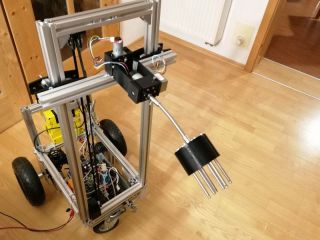Enrich 2023
The European Robotics Hackathon
I can highly recommend visiting Enrich. Already the exclusive guided tour through the power plant is worth it. We participated with the hexapod and my robot Lois. The hexapod had some electrical problems and could not participate. Anyway, we had 3 successul rounds with Lois and could also find some artifacts and create a 3D map of a small part of the area. So it was not a complete shame Update: 8/11/2023 — The Full Story
I totally underestimated how complicated is to operate a robot remotely but after the first round and some additional training I got familiar with the situation. The big problem at the competition is bad WIFI. Although it is provided by the organisator, it is a really bad connection because of the thick concrete walls and the robot also switches between multiple access points. So You can completely forget about using a distributed ROS setup or something similar. I fixed the problem by creating a tmux session, where I could give the robot simple commands like drive 1m on this course and then stop. For camera transmission X-forwarding worked kind of well. The whole mapping was running on the robot and based on rtabmap.
Next year the organizer wants fully autonomous robots.
In the end many other teams had the same problems and it was a great week anyway. I would definitely go there again.
|
Control room |
|
Display |
|
Hexapod |
|
Lois |
|
3D Map |
|
Power plan |
|
Reactor |
|
Reactor door |
ENRICH - The European Robotics Hackathon
Incidents such as Fukushima, Majak or Chernobyl as well as the decommissioning and dismantling of old nuclear facilities (e.g. Sellafield, Asse or Murmansk) have taught us that the use of robotics technology has clear advantages. There are many measurement and sampling tasks too risky for humans to carry out. For these radiological and nuclear (RN) scenarios specialized robot systems have to be developed.
ENRICH takes place every two years at Zwentendorf Nuclear Power Plant in Austria. The organisers are The Austrian Armaments and Defence Technology Agency (ADTA), EVN AG, European Robotics and mainly the Cognitive Mobile Systems Department of the Fraunhofer Institute for Communication, Information Processing and Ergonomics FKIE. The event is not organised as a competition but as a trial. There are some awards for best performance in specific subject areas. The main goal of the event is to give the teams the ability to demonstrate and test their technology in a realistic enviroment. The boiling water reactor of Zwentendof NPP ist perfect for this. This power plant was completed but never put into operation, so there is no high level of radioactivity. Already the exclusive guided tour through the power plant is worth visiting ENRICH
ENRICH 2023 (10.6.23 - 16.6.23)
There were four tasks at ENRICH 2023:
- Mapping: Draw a digital 3D map of the power plant and a heat map of artifically placed real radiation sources.
- Manipulation: Identify pipes containing radioactive coolant and close the corresponding valves.
- Search and Rescue: Move dummy humans to a safe area with Your robot.
- UAV: Do the Mapping task with an UAV (in a different area).
I joined 107-Systems as one of the 13 teams going for ENRICH 2023. We participated with a hexapod called L3XZ and my differentially driven robot Lois one might know from different competitions. We decided to go for the mapping and manipulation tasks. For mapping I set up RTAB-Map using an Intel Realsense D435i and a SICK Lidar as source for odometry data. For the manipulation task a portal frame was added on the back of Lois. I 3D-printed a drum shaped tool with a camera in it's middle in order to be able to open and close the valves.
There are three runs. As the hexapod had some electrical problems we only participated with Lois. I totally underestimated how complicated it is to operate a robot remotely and crashed the valve manipulation tool by driving backwards into a door during round one. After the first round and some additional training I got familiar with the situation. One problem at the competition is bad WIFI. Although it is provided by the organisator, it is a really bad connection because of the thick concrete walls and the robot also switches between multiple access points. So You can completely forget about using a distributed ROS setup or something similar. I fixed the problem by creating a tmux session, where I could give the robot simple commands like drive 1m on this course and then stop. For camera transmission X-forwarding worked kind of well. The whole mapping was running on the robot itself, so it was not affected by connectivity issues.
Anyway, we had 3 successul rounds where Lois came back from the area to be explored. We could also find some radioactive artifacts and create a 3D map of a small part of the area.
Many other teams had the same problems and it was a great week anyway. I would definitely go there again. Next year the organiser wants fully autonomous robots.

